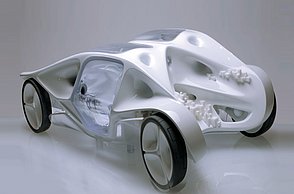Course of studies
The study program begins according to the concept of the Pforzheim Model with a high proportion of artistic work and theoretical subjects. In the course of the study, the study content and the teaching and processing time spent on it shift steadily in the direction of subject-related and subject-specific content (project work).
These project works begin in the first semester as a compact project on the topic of innovative materials and their use, increase in the second semester to weekly short projects, and from the third semester onwards always run as a main project. An exterior design (3rd/4th semester) and an interior design (6th semester) to be developed over the course of the entire semester (approx. 17 weeks) form the core of the teaching content. Theoretical and practical subsidiary subjects relate - as far as possible - to the topic of the main project (see list below in excerpts).
In the 5th semester, students complete a mandatory industrial internship of at least 100 working days.
The designs created as part of the project work are each implemented as a CAD/CAS model (3rd semester), as a physical scale model in clay (4th semester) or as a scale model in mixed construction (6th semester).
The standard period of study is seven semesters. The last semester includes the development of the thesis, which consists of a theoretical and a practical part (scale model).
List of subjects (excerpt):
- Project work (major subject)
- CAD/CAS (computer modeling and image generation (rendering))
- General model making and clay model making
- Representation techniques (rendering, drawing, Photoshop rendering)
- General design theory and automotive design theory
- Ergonomics
- Aerodynamics
- Marketing
- Design history and automotive design history
- Color&Trim
Why study Transportation Design in Pforzheim?
Our graduates are able to design vehicles or vehicle categories and apply them on a technical basis (rough or detailed package), present the results, prepare and present them for the appropriate form of presentation. Their contact knowledge enables them to communicate with both marketing staff and development engineers on a technical level, allowing them to work in multidisciplinary team structures. It is possible for them to supervise the conversion of a design into a scale or 1:1 model in collaboration with a modeler or modeling team.






















